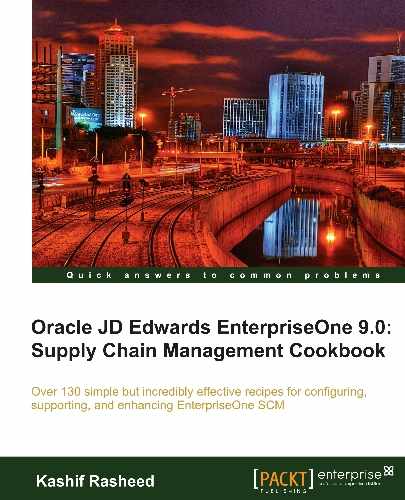You can accurately plan for future stocking needs by reviewing information that the system provides about both the item and the quantity. For example, you can:
- Access information about stock items
- Access summary and detailed information about on-hand, committed, and available items
- Access item information about previous sales, current inventory quantities, and future receipts
- Review balance forward records for a specific fiscal year
- Reconcile inventory balances with the general ledger (GL), and access detailed item transaction information
- Compare the inventory balances at the end of one period with the same period end for the GL
Before you complete the tasks in this recipe, you must:
- Set up the system to calculate availability for Manufacturing Processes if you are using the JD Edwards EnterpriseOne Product Data Management system
- Set up location segments, in order for information to be available
- Verify that the system is set up to calculate availability for inventory items
- On the Work With Item Availability form from the Inventory Management Inquiry menu, enter the item number for reviewing item quantities.
- Enter the branch/plant number for searching for a specific branch/plant.
- Review the item quantities, such as On-hand, Available, Committed, and so on.
- Click on Summary to review the quantity at the branch/plant level.
Item Availability is the number of items that you can use based on user-defined calculations. You determine how the system calculates item availability by defining the factors that subtract from or add to the available quantity of an item. This calculation can include quantities that do not immediately affect on-hand amounts. For example, you can set up the availability calculation to subtract any quantities that are committed to sales or work orders, and add any quantities that are on purchase orders or in transit.
Available to Promise (ATP) refers to the number of items that are uncommitted (available for sales or distribution) until the next replenishment orders arrive. You select whether to use the basic method or the cumulative method to determine ATP. The basic method assumes customer demand only, such as sales orders. It also fulfills demand for all periods until the next replenishment order arrives, such as purchase orders. You can review the number of items that are in a specific lot, as well as the activity dates, item quantities, and hold statuses that pertain to the lot. The activity date and quantity information reflect transactions such as issues, receipts, and sales. If the same item or lot appears more than once, then the item exists in multiple locations. You can locate the on-hand quantity and accounting information for a specific transaction date and document number in the Item Ledger Inquiry (CARDEX) (P4111). The Item Ledger Inquiry (CARDEX) contains transaction history such as sales, receipts, and transfers for each item in inventory. Each entry represents a transaction that affects the on-hand quantity of an item. You can review a transaction to determine both item quantities and the related costs, for any branch, location, or lot as of a particular date. You can also see any transactions for that item that have taken place as of a specific date and locate information about quantities that are deducted from the on-hand quantity.
When you create transactions such as issues, transfers, and adjustments, you can locate item information and return this information to the transaction that you are creating. Locating and returning information such as location, lot number, grade, potency, expiration date, and lot status code can save you entry time and reduce errors. Use the Item Search Returns Quantity Program (P40ITM2) to locate and return the information for items to the Transaction Entry form, that is. Inventory Issue (P4112), and Inventory Adjustment (P4114). If you use quality mode, only branches/plants and grade and potency information that is specified in the customer preferences are available.
You can locate item information using criteria that you define for each branch/plant. After you locate the item information, you can also access quantity information about the item. You can define specific criteria for an item search. Use this type of search when you know what the item is, but you want to limit the search. For example, you can limit the search for an item to a specific branch/plant and supplier.

Suppliers can use the Web to enquire about the items that they supply. They can check the availability and on-hand quantity of those items so that they can determine whether to use other programs in supplier self-service to create purchase orders or to issue quotes. Reviewing inventory levels from the Web enables the supplier to maintain a predictable delivery of goods and services, which facilitates better communication and a better working relationship. It also enables the supplier to prepare for future activity, gather information on particular trends, and prepare for surpluses and shortages. Using their item number, suppliers can review information such as Branch/plant, Quantity On-hand, Quantity on Purchase Order, Location, Lot/Serial Number, and Short Item Number. The supplier can also have the system display the information in detail mode by un-checking the Summary Only check box.
